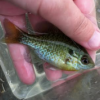We have what I believe is some form of red hornwort in our rivers. It's wider than most hornwort I've seen, but it has the same structure and texture. It grows in clumps from the bottom of the river to the surface, so it's at least five feet long in deeper areas. From what I've seen in shallow areas, it has roots, but the roots are usually just clinging into rock.
I've tried a couple of times to bring some back and keep it, but it doesn't seem to like being left in a bucket to check for pests.
I currently have duckweed acting as the nitrate sucker in my sunfish tank, but I can scoop the majority of it out. I'd like to replace it with something more natural, especially since that's what the sunfish like to hide around in their river.
My smallest fish is about 2 1/2" long, so I don't think I have to worry about dragonfly larvae or such. Given that and its apparent dislike of quarantine, would it be safe to just firmly rinse the hornwort and then put it in the tank? I know leeches are a concern, but leeches don't like fast water, and I can get the hornwort from a faster-flowing section of the river. Could that work?
Basically: There's red hornwort in the river near me, and I want it for my sunny tank. How do I make it grow and be happy?












